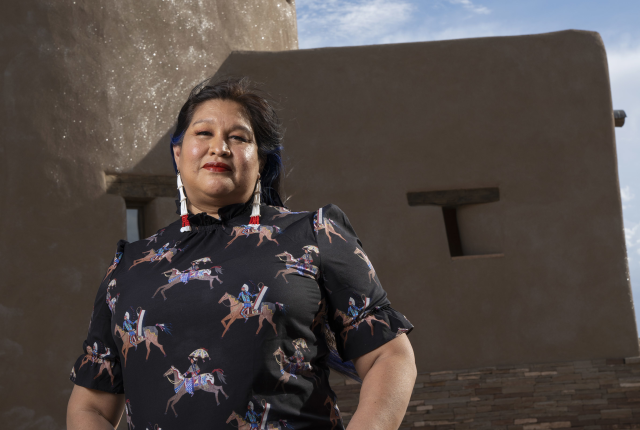This essay is one of 70 by mostly Pueblo people—artists, writers, historians, scientists, and political leaders—collected for "Grounded in Clay: The Spirit of Pueblo Pottery," an exhibition that runs through May 29, 2023, at the Museum of Indian Arts & Culture. For an insider's look at the exhibit, read "Pueblo Pottery Exhibit Breaks the Mold," by Kate Nelson.
THE OBLIQUE 6 A.M. LIGHT moves through my bathroom window at Ohkay Owingeh. As I awaken and begin to shower, I see lines of deer antlers bobbing outside the window. Hundreds of dancers, from oldest to youngest, line up and move rhythmically in unison to the pulsing cadence of the drums and singers. Low-bass drumbeats reverberate through the plaza as the dancers—dressed in white and wearing headdresses made of river reeds painted yellow with a green horizontal band—snake their way across the space.
This house has been in my family for hundreds of years. The U.S. Department of Housing and Urban Development (HUD) has renovated the property, which has thick, biomorphic adobe walls with sloping, asymmetrical lines. The walls are so thick that a child has space enough to curl up in the window wells and sunbathe. An old cannonball is embedded in the wall footings. The ceilings are built from traditional wooden beams with thatch filling. The houses are constructed organically, connecting to one another in classic Pueblo block-house designs. The lines of rooms form patterns that describe the plazas, and the plazas form patterns that describe the village.
Ahead of this morning’s Deer Dance, we have cleaned the yards and houses in preparation for the ceremony. Part of my family’s house was demolished by HUD in the renovations, but the footings of the ghost rooms are still visible. I am pulling weeds from the ground in one of these former rooms when I strike the edge of a potsherd. It seems to be a large rim piece, buried in the old floor space. I dig further and breathe fast with anticipation as it becomes clear that an entire pot is hidden in the cool earth. The pot that emerges is a large Tsankawi-type reproduction,* maybe 200 years old. It is gray with interlocking painted badger paws. The paws have several meanings, including earth, underworld, shipap,** medicine, burrowing creature, and life.
We remove the pot in pieces and contact our conservator friends to restore it to its near-original form. Then we rebury the vessel in its resting place with cornmeal and prayers. I think it is still waiting there. As I walk through the School for Advanced Research pottery vault, the badger-paw motif painted on the pot on the shelves reminds me of that day.
*Tsankawi is a historical Pueblo pottery type.
**A shipap is a place of emergence from the underworld and an earth navel, through which prayers pass.
Read More: Don't miss essays by Diego Medina, Claudia Mitchell, Evone "Snowflake" Martinez, Mateo Romero, and Dominique Toya.



